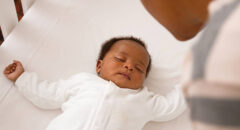
Babies' skin is lauded for being very supple, fragrant, and silky. However, that is not always the case. Rashes, pimples, and scales are common temporary skin conditions in infants, often taking parents by surprise.
Here is a lesson on common problems and illnesses that might arise in a baby's first year, along with advice on how to care for them.
Scratches
Even though newborns' nails are often very soft, they may be extremely sharp due to their thinness and length. When you consider that infants can't yet regulate their hand motions, you can imagine how easily their delicate faces may be scratched (or yours).
Minor scratches need nothing more than gentle cleaning and a pat-drying. Ointment is suggested by pediatricians and is safe for minor cuts and scrapes. Cut your baby's nails frequently or use a soft emery board to file them down as they develop. While your infant is napping is a great time to get this done.
RELATED: 6 Tips For Caring for a New Baby’s Skin, Hair and Nails
Baby Acne
Acne is fairly prevalent in infants. Although you would assume it won't show up until puberty, it can appear as early as two or three weeks after birth. There is a red or white color to the bumps. The cheeks are the most common location, although they may also appear on the forehead, chin, and back.
The root cause of acne in infants remains unknown. Some professionals say that the surge in pore-clogging oil production towards the end of pregnancy is caused by the mother's hormones. Screaming increases blood flow to the skin; thus, the acne seems worse while your infant is irritable or crying.
Baby acne is treated with the knowledge that it is safe and will go away on its own within a few weeks. (If not, see your child's pediatrician.) Use water or a gentle baby soap to clean your baby's skin, then pat dry. Don't scrape or use any harsh cleaners for the time being.

Cradle Cap
This common infant ailment often presents much worse than it really is. Your kid probably won't be bothered by the crusty, scaly, or flaky patches of skin that make up the cradle cap on his or her head.
Most cases appear in the first few months of infancy and resolve without treatment within 6-12 months. It may be tied to hormones or yeast, but experts aren't sure. There is no spread of cradle cap.
Cradle cap usually doesn't need any treatment, but if you want to, you may release the scales by massaging your baby's scalp with a soft brush or cloth, bathing and rinsing well, and then gently brushing your baby's scalp.
As a treatment, refrain from picking at the scales or attempting to scrape them off. Talk to your baby's doctor if the cradle cap doesn't clear up after milder treatments or if you wish to try anything stronger.
RELATED: Gabrielle Union & Dwayne Wade “Proudly” Debut Their New Baby Skincare Line
Drool Rash
While most infants may drool at some point, teething can bring out the floodgates for certain children. (Usually between four and seven months, however, it may happen sooner or later for certain newborns.)
Your baby's face, chin, and neck will be moist nearly continuously from the excess drool, which may irritate the skin and cause redness and swelling (drool rash).
Keep several spares available to prevent your baby's neck from being irritated by a wet shirt or onesie. Pat the skin dry, then apply an ointment to help calm irritation and seal in moisture. As an added bonus, there are absorbent bibs.

Diaper Rash
No matter how often you change your baby's diapers, he or she will almost certainly get diaper rash at some time in the first year of life. Why? Even the most absorbent diaper will leave some moisture on the baby's skin, and some infants have more delicate skin.
When newborns first start consuming solid meals, their feces alter composition in ways that might irritate their skin, increasing the incidence of diaper rash.
The best method of treatment is prevention. Diaper changes should be frequent, and you should let your child go without diapers for short periods of time.
Kindly attend to a rash. Avoid using scented or alcohol-based wipes, and don't rub (plain water is best). Zinc oxide, included in most diaper rash ointments, is a barrier against moisture while soothing your baby's irritated skin.









